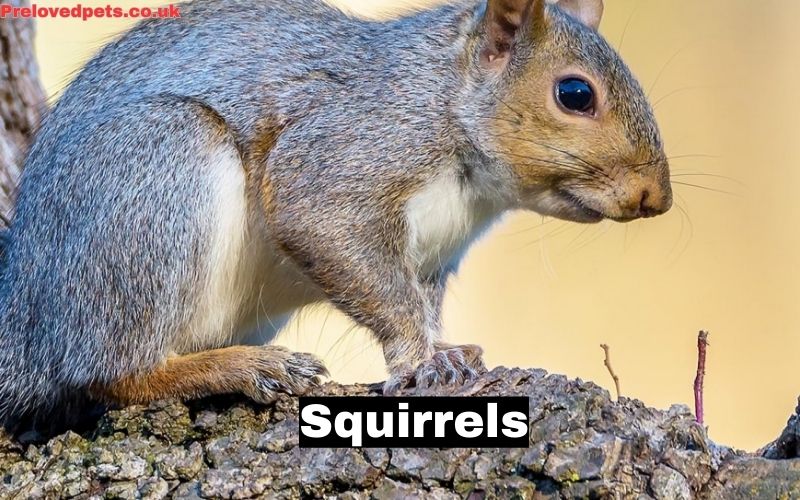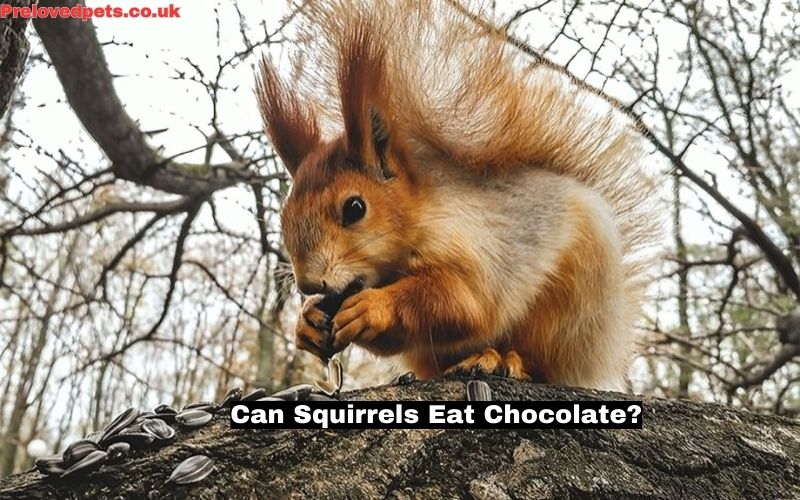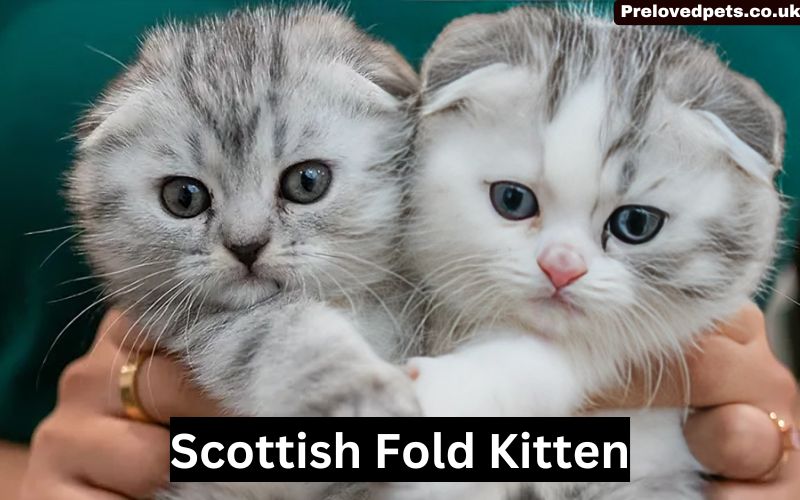Squirrels are enchanting creatures known for their playful behavior and bushy tails. They are a common sight in parks, forests, and even urban settings. Many people enjoy feeding squirrels and watching them nibble on various treats. However, not all human foods are safe for these small mammals. One of the most debated topics is whether squirrels can eat chocolate. This article explores the effects of chocolate on squirrels, why it can be harmful, and provides safer alternatives for those who wish to offer food to these delightful animals.
Understanding Squirrels’ Dietary Needs

Squirrels are primarily herbivores, although they occasionally consume animal-based foods. Their natural diet consists of nuts, seeds, fruits, vegetables, fungi, and occasionally insects. These foods provide essential nutrients, including proteins, fats, carbohydrates, vitamins, and minerals, crucial for their growth, energy, and overall health.
Squirrels have a high metabolic rate, meaning they require a steady intake of calories to maintain their energy levels. Their diet needs to be nutrient-dense to support their active lifestyle, particularly as they prepare for winter by storing food. While they are opportunistic feeders and might sample various foods, not everything they eat is beneficial or safe.
The Composition of Chocolate
Chocolate, a popular human treat, is derived from cacao beans. Its appeal lies in its rich taste and texture, which is achieved through a combination of cacao solids, cacao butter, sugar, and other ingredients. The components of chocolate that are of concern regarding animal consumption include:
- Theobromine: This is the most significant toxic compound found in chocolate. Theobromine is a methylxanthine, a group of compounds that also includes caffeine. It acts as a stimulant, affecting the central nervous system, cardiovascular system, and kidneys. While humans can metabolize theobromine relatively quickly, many animals, including squirrels, cannot, leading to toxic accumulation.
- Caffeine: Another methylxanthine, caffeine, works similarly to theobromine but is present in smaller amounts in chocolate. It also stimulates the nervous system and can exacerbate the toxic effects when combined with theobromine.
- Sugar: Chocolate contains high levels of sugar, particularly in varieties like milk chocolate and white chocolate. While sugar itself isn’t toxic in small amounts, it can contribute to obesity, dental problems, and metabolic issues in squirrels.
- Fat: Chocolate, especially in the form of milk chocolate, contains significant amounts of fat. High-fat diets can lead to obesity and related health problems in squirrels, including cardiovascular disease and fatty liver disease.
- Additives and Fillers: Processed chocolate products often contain additional ingredients, such as artificial flavors, preservatives, emulsifiers, and fillers. These additives can further complicate the potential health risks to squirrels.
Theobromine and Its Toxicity
Theobromine is the primary cause of chocolate toxicity in animals. Its effects are dose-dependent, meaning the severity of symptoms depends on the amount ingested and the animal’s size. Squirrels, being small creatures, are particularly vulnerable to the toxic effects of theobromine, even in minute quantities.
Mechanism of Theobromine Poisoning
Theobromine affects various body systems in squirrels:
- Central Nervous System: As a stimulant, theobromine increases neuronal activity, which can lead to hyperactivity, restlessness, tremors, and seizures. In severe cases, it can cause excitotoxicity, a condition where nerve cells are damaged and killed due to excessive stimulation.
- Cardiovascular System: Theobromine increases heart rate and can cause arrhythmias, such as tachycardia (abnormally fast heart rate) and, in severe cases, cardiac arrest. These effects are particularly dangerous for squirrels, whose small size means their heart rate and blood pressure can be significantly affected by even small doses.
- Respiratory System: In severe cases, theobromine toxicity can lead to respiratory distress or failure. This occurs due to its stimulatory effects on the nervous system, which can disrupt normal breathing patterns.
- Gastrointestinal System: Theobromine can irritate the stomach and intestines, leading to symptoms such as vomiting, diarrhea, and abdominal pain. These symptoms can cause dehydration, which is particularly dangerous for small animals like squirrels.
- Renal System: As a diuretic, theobromine increases urine production, potentially leading to dehydration and kidney stress.
Symptoms of Theobromine Poisoning in Squirrels
The symptoms of theobromine poisoning in squirrels can vary depending on the amount consumed and the individual squirrel’s sensitivity. Common signs of poisoning include:
- Restlessness and Hyperactivity: One of the earliest signs of theobromine poisoning is increased restlessness and activity. Squirrels may appear agitated, run around excessively, or seem unable to settle down.
- Tremors and Seizures: As the poisoning progresses, squirrels may develop muscle tremors or even seizures. These are serious symptoms indicating severe neurological distress.
- Increased Heart Rate: A rapid heartbeat is another common symptom. This can be difficult to observe in wild squirrels, but a visible sign may be labored breathing or difficulty catching their breath.
- Vomiting and Diarrhea: Gastrointestinal symptoms like vomiting and diarrhea may occur, leading to further complications such as dehydration.
- Weakness and Lethargy: In severe cases, squirrels may become weak or lethargic, showing a lack of coordination or inability to move properly. This can be a precursor to more severe symptoms, including coma or death.
Different Types of Chocolate and Their Theobromine Content
Not all chocolate is created equal when it comes to theobromine content. The type of chocolate significantly influences its toxicity level:
- Dark Chocolate: This variety contains the highest concentration of theobromine, ranging from 5 to 16 mg per gram. Dark chocolate is particularly dangerous for squirrels, as even a small amount can lead to severe poisoning.
- Milk Chocolate: Contains lower levels of theobromine, around 1.5 to 2.5 mg per gram. However, due to the presence of other harmful ingredients like sugar and fat, it is still unsafe for squirrels.
- White Chocolate: Technically, white chocolate contains negligible amounts of theobromine because it is made from cocoa butter, sugar, and milk solids without cocoa solids. However, its high sugar and fat content can still pose health risks to squirrels, such as obesity and dental problems.
Given these differences, even a small piece of dark chocolate can be potentially lethal to a squirrel, while larger quantities of milk or white chocolate are also harmful due to their other unhealthy components.
Case Studies and Observations
Wildlife rehabilitation centers and veterinarians have documented numerous cases of chocolate poisoning in wildlife, including squirrels. These cases often arise from well-meaning individuals offering chocolate or squirrels scavenging discarded chocolate products. The symptoms observed in these cases range from mild gastrointestinal distress to severe neurological symptoms and even death.
For instance, a report from a wildlife rehabilitation center in an urban area detailed several cases of squirrels brought in with symptoms consistent with chocolate poisoning. These squirrels were found near public parks, likely having consumed chocolate discarded by park visitors. The affected squirrels exhibited hyperactivity, vomiting, and, in severe cases, seizures. While some recovered with supportive care, others did not survive, highlighting the potential lethality of chocolate ingestion.
Legal and Ethical Considerations
Feeding wildlife, including squirrels, is subject to legal and ethical considerations. In many jurisdictions, feeding wild animals is discouraged or regulated due to the potential negative impacts on both the animals and the ecosystem. The introduction of non-native or processed foods can disrupt local ecosystems, alter animal behaviors, and lead to dependency on human-provided food sources.
Feeding squirrels and other wildlife can make them less wary of humans, increasing the likelihood of human-wildlife conflicts. For example, squirrels that become accustomed to being fed may approach humans more frequently, leading to situations where they may be perceived as pests or nuisances. Additionally, feeding wildlife can cause imbalances in natural food sources and disrupt ecological relationships.
From an ethical standpoint, feeding wildlife should be done with careful consideration of the animals’ health and natural behaviors. Providing foods that are not part of their natural diet, such as chocolate, can cause harm and suffering. It’s essential to prioritize the well-being of wildlife and ensure that any interactions with them do not negatively impact their health or survival.
Safe Alternatives for Feeding Squirrels
For those who enjoy feeding squirrels and wish to do so responsibly, there are many safe and nutritious alternatives to chocolate. These options provide essential nutrients without the harmful effects associated with chocolate consumption:
- Nuts: Unsalted, raw nuts like walnuts, almonds, hazelnuts, and pecans are excellent choices. They are high in healthy fats and proteins, supporting a squirrel’s energetic lifestyle. However, nuts should be offered in moderation, as excessive consumption can lead to weight gain.
- Seeds: Pumpkin seeds, sunflower seeds, and other unsalted seeds are nutritious and loved by squirrels. Seeds provide essential fatty acids and are a natural part of a squirrel’s diet.
- Fruits: Small amounts of fresh fruits, such as apples, berries, grapes, and bananas, can provide vitamins and hydration. However, fruit should be given sparingly due to its high sugar content, which can lead to dental issues and obesity if consumed in excess.
- Vegetables: Leafy greens, carrots, peas, and other vegetables are low-calorie, nutrient-rich options. These foods offer vitamins and minerals that are beneficial for squirrels. Avoid starchy vegetables like potatoes, as they are less suitable for a squirrel’s digestive system.
- Specialty Wildlife Foods: Many stores offer specially formulated wildlife foods designed to meet the dietary needs of animals like squirrels. These products are balanced and safe, providing essential nutrients without harmful additives.
Creating a Safe Feeding Environment
If you choose to feed squirrels, it’s essential to create a safe and controlled environment:
- Use Squirrel Feeders: Squirrel feeders can help keep food off the ground, reducing the risk of attracting other wildlife or pests. These feeders also prevent squirrels from eating spoiled or contaminated food.
- Avoid Overfeeding: Providing too much food can lead to dependency and reduce a squirrel’s natural foraging behavior. It can also cause health issues like obesity. Feed squirrels only occasionally and in moderation.
- Offer Water: In addition to food, providing clean, fresh water can be beneficial, especially during hot weather. A shallow water dish placed in a shaded area can help squirrels stay hydrated.
- Respect Their Habitat: Avoid interfering with squirrels’ natural behaviors and habitat. Feeding should not disrupt their daily activities or cause them to become reliant on human-provided food.
Conclusion
Squirrels are delightful creatures that add charm to our natural and urban landscapes. While it may be tempting to share our favorite treats with them, it’s essential to remember that not all human foods are safe for wildlife. Chocolate, despite its popularity among humans, poses a significant risk to squirrels due to its theobromine content and other unhealthy components. Even small amounts of chocolate can cause severe health issues or death in these small mammals.
To ensure the well-being of squirrels, it’s crucial to provide safe and nutritious alternatives that align with their natural diet. Nuts, seeds, fruits, and vegetables are excellent choices that offer essential nutrients without the risks associated with chocolate. By feeding squirrels responsibly and respecting their natural behaviors, we can enjoy our interactions with these charming animals while promoting their health and safety.
Ultimately, the best way to support wildlife is to respect their natural diet and environment. Providing appropriate food and creating a safe feeding environment allows us to appreciate and protect the animals that share our world. Remember, when it comes to feeding wildlife, less is often more, and a little kindness goes a long way in ensuring their well-being.
For More Information, Visit: Preloved Pets




